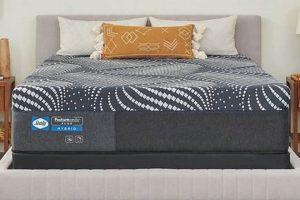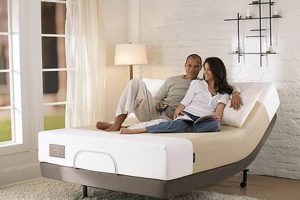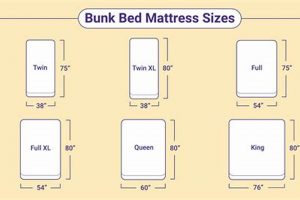A sleeping arrangement characterized by one bed frame stacked atop another. Typically, this configuration is designed to accommodate two individuals in a single room, maximizing floor space. A separate, cushioned sleeping surface is required for each level of the frame to ensure comfortable rest. For example, in a child’s bedroom shared by siblings, this arrangement provides individual sleeping spaces while preserving play area.
This vertically oriented bedding system offers multiple advantages, including efficient utilization of limited square footage. Historically, such arrangements have been prevalent in settings where space is constrained, such as military barracks, summer camps, and hostels. Furthermore, the design can foster a sense of camaraderie among occupants while addressing spatial limitations.
The subsequent sections will delve into variations in frame construction, safety considerations, mattress selection criteria, and best practices for maintaining the integrity and longevity of this specific furniture combination.
Essential Considerations for Bunk Bed and Mattress Selection
The following points outline critical factors to consider when choosing this specific furniture combination. Adherence to these guidelines can enhance safety, comfort, and longevity.
Tip 1: Prioritize Safety Standards: Ensure the chosen bed frame meets or exceeds established safety regulations, such as those defined by ASTM International. Verification of certification markings is crucial.
Tip 2: Evaluate Weight Capacity: Determine the maximum weight the upper bunk can safely support. This is especially pertinent for older children or adults using the unit. Exceeding the limit can lead to structural failure.
Tip 3: Select Appropriately Sized Mattresses: Use mattresses that fit the frame dimensions precisely. Gaps between the mattress and frame create potential entrapment hazards. Refer to the manufacturer’s specifications.
Tip 4: Consider Mattress Thickness: The mattress for the upper bunk should not be so thick as to reduce the height of the safety rails. Adequate rail height is essential to prevent falls. Observe recommended maximum mattress height limits.
Tip 5: Inspect Ladder or Staircase Stability: Confirm the ladder or staircase provides secure and stable access to the upper bunk. Regularly check for loose screws or damaged components. Proper assembly is crucial.
Tip 6: Mattress Firmness and Support: Select mattresses that provide adequate support and spinal alignment. Consider the age and weight of the intended user when determining the appropriate firmness level.
Tip 7: Material and Construction Quality: Inspect the materials used in both the bed frame and mattresses. Opt for durable, non-toxic materials. Verify the quality of construction to ensure long-term stability and resistance to wear and tear.
Implementing these recommendations promotes a safe and comfortable sleeping environment while maximizing the functional lifespan of the chosen system. Careful planning and attention to detail are paramount.
The following sections will address specific scenarios and considerations related to maintenance and potential upgrades.
1. Spatial Efficiency
The defining characteristic of a vertical bedding system is its ability to address constraints in available square footage. The inherent design, with one sleeping platform stacked directly above another, enables two occupants to occupy the same floor space as a single conventional bed. This is achieved by exploiting vertical space that would otherwise remain unused. As a direct consequence, remaining floor area can be allocated to other essential functions, such as studying, playing, or storage.
In environments with limited dimensions, the value proposition is particularly evident. Consider densely populated urban areas where apartment sizes are often restricted. These can be very important to optimize the available area with use of vertical bedding systems. Similarly, in shared living quarters like military barracks or student dormitories, the utilization of vertical bedding systems is crucial for accommodating multiple individuals without compromising personal space.
In summary, this type of furniture contributes to the efficiency of a room by leveraging unused overhead space. Understanding this space efficiency is crucial for maximizing the use and value of a limited area. Moreover, this space saving often translates to an increase of comfort, and ease to move in the given area.
2. Structural Integrity
Structural integrity is paramount to the safe and effective use of vertically stacked sleeping systems. The bed frame’s capacity to withstand applied loads and maintain stability directly impacts occupant safety and the system’s long-term usability.
- Material Selection and Load Bearing Capacity
The choice of materials, such as solid wood, engineered wood, or metal, dictates the frame’s inherent strength. Different materials possess varying load-bearing capacities. For instance, solid hardwood generally exhibits superior strength compared to particleboard. Adequate load-bearing capacity is crucial to prevent structural failure under static and dynamic loads (e.g., the weight of occupants and movement during sleep). Exceeding the manufacturer’s stated weight limits poses a significant safety risk.
- Joint Design and Connection Strength
The design and execution of joints, where individual frame components connect, are critical for overall stability. Secure, well-engineered joints distribute loads evenly throughout the structure. Common joint types include mortise-and-tenon, dowel joints, and bolted connections. Poorly constructed or weakened joints can lead to racking (lateral movement), instability, and eventual collapse. Regular inspection of joints is essential to identify and address potential weaknesses.
- Ladder/Staircase Integration and Stability
The ladder or staircase provides access to the upper bunk and must be integrated securely into the frame. The connection points must withstand repeated use and significant weight transfer. A wobbly or unstable ladder/staircase presents a fall hazard. Design considerations include proper angle, step depth, and handrail support. Material selection and construction quality are as important for the access system as they are for the bed frame itself.
- Guardrail Design and Effectiveness
Guardrails on the upper bunk are a primary safety feature designed to prevent falls. Their height, spacing between vertical members, and attachment strength are critical parameters. Regulations often specify minimum guardrail height and maximum opening sizes to prevent entrapment. Effective guardrail design considers both static resistance to leaning forces an
d dynamic resistance to impact. Regular inspection ensures the guardrails remain securely attached and undamaged.
The interrelationship between these factors determines the overall structural integrity. A deficiency in any one area compromises the entire system’s safety and functionality. Periodic inspections, adherence to weight limits, and prompt repair of any damage are essential for maintaining a safe sleeping environment. The longevity and safety of this furniture investment hinges on a robust and well-maintained structure.
3. Occupant Safety
The configuration of a vertically stacked sleeping arrangement inherently introduces specific safety concerns that necessitate careful consideration. Falls from the upper bunk represent a primary risk, potentially resulting in injuries ranging from minor contusions to severe fractures or head trauma. The design of the bed frame, particularly the presence and dimensions of guardrails, directly influences the likelihood of such incidents. Inadequate guardrail height or spacing may fail to prevent accidental falls, especially during sleep or for occupants prone to restlessness. Real-world incidents have demonstrated the critical role of properly designed and maintained safety features in mitigating fall-related injuries. Similarly, the stability and accessibility of the ladder or staircase significantly affect the risk of falls during ascent and descent. A poorly designed or maintained access system can contribute to slips, trips, and subsequent injuries.
Entrapment hazards present another significant safety concern. Gaps between the mattress and the bed frame, particularly in the upper bunk, pose a risk of entrapment, especially for young children. Such entrapment can lead to suffocation or other serious injuries. Strict adherence to mattress size specifications and regular inspection for gaps are crucial preventive measures. Additionally, the materials used in the construction of both the bed frame and the mattress impact occupant safety. The use of non-toxic, flame-retardant materials minimizes the risk of exposure to harmful chemicals and reduces the flammability of the structure, mitigating potential fire hazards. The weight capacity of the upper bunk represents a critical safety parameter. Exceeding the manufacturer’s recommended weight limit can lead to structural failure, increasing the risk of collapse and subsequent injuries.
In summary, occupant safety is an indispensable component of vertically stacked sleeping arrangements. Mitigating fall hazards, preventing entrapment, utilizing safe materials, and adhering to weight limitations are paramount. Comprehensive risk assessment, strict adherence to safety standards, and regular maintenance are essential to ensure a safe sleeping environment. The understanding of these factors, in turn, informs responsible selection, assembly, and usage practices. Ignoring safety considerations elevates the potential for severe consequences; therefore, prioritize occupant safety is paramount.
4. Sleeping Comfort
Sleeping comfort, when considering vertically stacked bedding systems, represents a critical factor influencing the overall value and suitability of such arrangements. The connection between sleeping comfort and this specific type of furniture set is multifaceted. Primarily, the selection of an appropriate mattress directly impacts the user’s physical well-being and quality of rest. A mattress that fails to provide adequate support can lead to discomfort, musculoskeletal strain, and disrupted sleep patterns. The confined space of a bed frame may also restrict airflow, potentially causing overheating and further disrupting sleep. The mattress chosen must address these potential challenges to ensure a restful experience.
Furthermore, environmental factors, such as noise and motion transfer between the upper and lower bunks, contribute to sleeping comfort. Individuals sleeping on the lower bunk may experience disturbances caused by movement on the upper bunk. Similarly, ambient noise levels can disrupt sleep, particularly in shared living spaces. Mitigation strategies include using noise-dampening materials in the bed frame’s construction and implementing mattress designs that minimize motion transfer. The impact on sleeping comfort may also lead to changes in sleep patterns. Chronic sleep disruption can lead to daytime fatigue, reduced cognitive function, and decreased productivity. Therefore, in educational institutions and communal living arrangements, prioritizing sleeping comfort can enhance overall well-being and academic performance. Real-world examples abound, in situations where the occupants cannot get optimal sleeping comforts, then cause several symptoms like a headache, tiredness, and many more.
In conclusion, achieving optimal sleeping comfort when using vertical beds requires a comprehensive approach. Thoughtful mattress selection, noise and motion management, and consideration of environmental factors are all essential. Failure to address these considerations can lead to discomfort, sleep disruption, and diminished quality of life. The understanding and application of these principles are paramount to maximizing the benefits. It underscores the importance of viewing the bunk bed and mattress not merely as space-saving furniture, but as a system designed to promote restorative sleep, thus enhancing well-being.
5. Material Durability
Material durability constitutes a fundamental aspect influencing the longevity, safety, and overall value of any vertically stacked bedding configuration. The selection of materials directly affects the ability of the structure to withstand sustained use, resist wear and tear, and maintain structural integrity over an extended period. Substandard materials compromise the system’s load-bearing capacity and resistance to stress, potentially leading to premature failure and posing safety hazards. Real-world instances of beds constructed from low-grade materials, such as particleboard or insufficiently treated metal, illustrate this point. These beds are susceptible to warping, cracking, and joint separation, rendering them unstable and unsafe for occupancy.
The implications of inadequate material durability extend beyond immediate safety concerns. Frequent replacements due to premature wear and tear result in increased long-term costs. Furthermore, the environmental impact associated with discarding and replacing furniture contributes to resource depletion and waste generation. Conversely, utilizing durable materials, such as solid hardwood or high-gauge steel, enhances the lifespan of the arrangement, reduces replacement frequency, and minimizes environmental impact. For example, beds constructed from sustainably sourced hardwood and treated with durable, non-toxic finishes can withstand years of use, maintaining their structural integrity and aesthetic appeal. Moreover, the durability of the mattress materials, including the ticking (outer fabric) and internal components (springs, foam), directly affects comfort and support. Mattresses constructed from low-quality materials are prone to sagging, compression, and degradation, leading to discomfort and impaired sleep quality.
In summary, prioritizing material durability is crucial for maximizing the value, safety, and sust
ainability. Investing in beds constructed from high-quality materials translates into reduced replacement costs, enhanced safety, and minimized environmental impact. The selection of appropriate materials requires careful consideration of factors such as load-bearing capacity, resistance to wear and tear, and environmental sustainability. Understanding the practical significance of material durability empowers consumers to make informed purchasing decisions, ensuring long-term satisfaction and responsible resource management. The longevity of an investment of this kind hinges upon a mindful assessment of structural materials.
6. Height Restriction
Height restriction, within the context of vertically stacked bedding systems, is a critical safety parameter directly influencing the risk of falls from the upper bunk. Adherence to specified height limitations is essential for ensuring the effectiveness of safety barriers and minimizing the potential for injury.
- Guardrail Effectiveness and Upper Mattress Height
The height of the mattress on the upper bunk directly impacts the functional height of the guardrails. A mattress that is too thick reduces the effective height of the guardrails, diminishing their ability to prevent occupants from falling out of bed. Regulations and manufacturer guidelines typically specify a maximum allowable mattress thickness to maintain adequate guardrail protection. Non-compliance with these height restrictions compromises the safety of the upper bunk.
- Ladder/Staircase Design and Accessibility
Height restrictions also affect the design and placement of the ladder or staircase used to access the upper bunk. Excessive height can make it more difficult and hazardous to climb, increasing the risk of falls during ascent and descent. Conversely, insufficient height can result in a steep climbing angle, posing similar risks. Proper calibration of the access system’s height is crucial for promoting safe and comfortable use.
- Headroom and Comfort on the Upper Bunk
Limited headroom on the upper bunk can lead to discomfort and potential head injuries. Height restrictions imposed by the ceiling or other overhead structures can restrict movement and make it difficult for occupants to sit up comfortably. Adequate headroom is essential for ensuring a positive user experience and preventing accidental impacts. Consideration should be given to both the occupant’s height and the overall dimensions of the room.
- Age and Physical Capabilities of Occupants
Height restrictions should be tailored to the age and physical capabilities of the intended occupants. Younger children may have difficulty climbing onto a high upper bunk, while older individuals may experience mobility limitations that make it challenging to navigate a steep or narrow access system. Adapting the height of the bedding system to the specific needs of the user promotes safety and accessibility.
The interrelation between these height-related considerations underscores the importance of comprehensive planning when selecting and assembling vertically stacked bedding. Careful adherence to manufacturer guidelines, consideration of occupant characteristics, and attention to environmental factors are essential for optimizing safety and functionality. The limitations and physical requirements play a pivotal role in the practicality and suitability of the configuration.
Frequently Asked Questions Regarding Bunk Bed and Mattress Systems
The following questions and answers address common concerns and misconceptions surrounding the selection, use, and maintenance of vertically stacked bedding configurations. This information is intended to provide clarity and promote informed decision-making.
Question 1: What are the primary safety standards applicable to bunk bed and mattress combinations?
Relevant safety standards typically include those established by organizations such as ASTM International. These standards address issues such as guardrail height, ladder stability, and mattress size requirements. Compliance with these standards is crucial for minimizing the risk of injury.
Question 2: How frequently should a bunk bed and mattress system be inspected for potential hazards?
A thorough inspection should be conducted at least every six months, or more frequently if the system is subjected to heavy use. Inspections should focus on identifying loose hardware, damaged components, and any signs of structural weakness.
Question 3: What is the recommended weight limit for the upper bunk?
The weight limit varies depending on the specific model and construction. Consult the manufacturer’s specifications for the precise weight limit. Exceeding this limit can compromise structural integrity and increase the risk of collapse.
Question 4: What type of mattress is most suitable for a bunk bed, and how does thickness impact safety?
A firm mattress that conforms to the bed frame’s dimensions is generally recommended. The mattress thickness must not exceed the manufacturer’s specified maximum to ensure adequate guardrail height. Thicker mattresses can reduce the effectiveness of the safety barriers.
Question 5: How can motion transfer between the upper and lower bunks be minimized?
Using mattresses with motion isolation technology, such as pocketed coil systems, can reduce motion transfer. Additionally, ensuring the bed frame is securely assembled and properly supported minimizes vibration.
Question 6: What are the considerations for selecting materials to reduce fire risk?
Opt for mattresses and bed frames made from flame-retardant materials. Look for certifications indicating compliance with fire safety standards. Avoid using bedding made from highly flammable materials.
Proper selection, regular inspection, and adherence to safety guidelines are essential for ensuring the safe and effective use of vertically stacked bedding systems. The information provided here is for general guidance only and should not substitute professional advice.
The following sections will delve into specific maintenance procedures and troubleshooting techniques.
Conclusion
The preceding analysis has explored the multifaceted considerations surrounding bunk bed and mattress systems. From spatial efficiency and structural integrity to occupant safety and sleeping comfort, each element contributes significantly to the overall suitability and long-term performance of this furniture arrangement. Prioritizing robust materials, adhering to stringent safety standards, and understanding the implications of height restrictions are paramount. The selection of an appropriate mattress, tailored to the specific needs of the occupants, directly impacts the quality of rest and overall well-being.
Informed decision-making, coupled with diligent maintenance practices, is crucial for maximizing the value and ensuring the safety of a bunk bed and mattress investment. Understanding the intricate balance between space optimization and occupant safety will lead to responsible utilization and enhance the functionality of living environments. Continued vigilance and adherence to best practices remain essential for realizing the full potential of this widely utilized furniture configuration.







![Best Truck Bed Mattress [Your Adventure Bed Starts Here] Organic & Natural Mattress Buyer’s Guide: Non-Toxic Sleep Solutions Best Truck Bed Mattress [Your Adventure Bed Starts Here] | Organic & Natural Mattress Buyer’s Guide: Non-Toxic Sleep Solutions](https://mattressworldpa.com/wp-content/uploads/2025/07/th-7122-300x200.jpg)